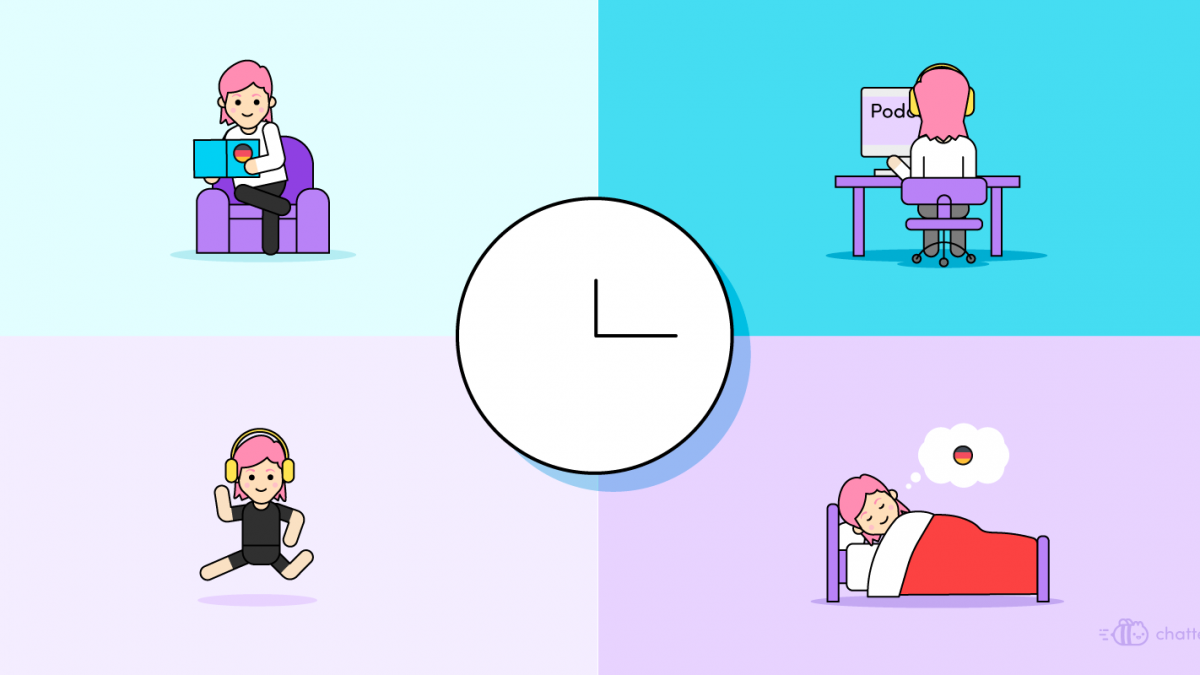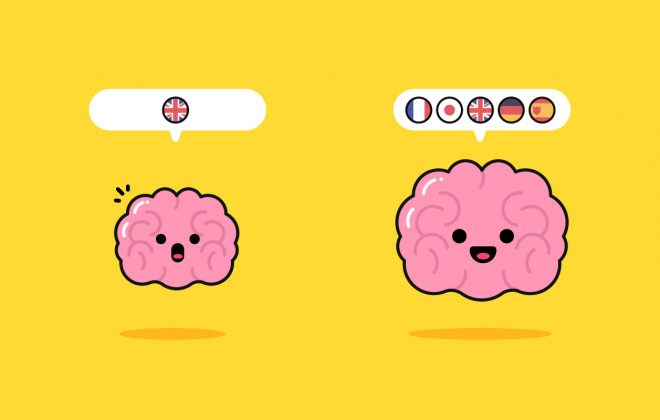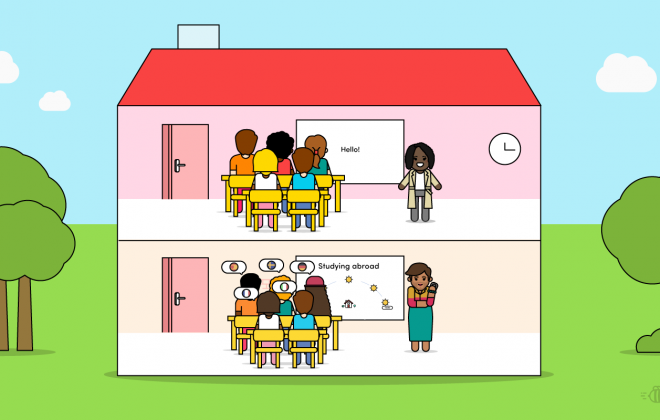ChatterConf: Optimize your day and maximize your learning
On the 23rd April, Chatterbug hosted Chatterconf, a virtual conference all about learning languages! Over the course of one day we virtually brought together language enthusiasts from all around the world to learn about the world of online language learning.
Below is a video of Mark Pentleton, founder of Coffeebreak Languages, and his presentation on how to best use your time for language learning. We’ve included a transcript underneath the video.
Video – Optimize Your Day and Maximize Your Learning
Transcript
Edited for readability
My presentation is basically going to be about how you can optimize your day and maximize your learning. By that I mean take advantage of the opportunities that you have in the course of a day to use those opportunities to learn and to improve your language skills in whatever way you can. In our typical days, in normal times perhaps, we have opportunities like going for a coffee or relaxing or going to the gym or even on your commute to work. But the fact is at the moment, this probably is more like what your day involves when you’re perhaps not allowed to get out.
Perhaps you have to work by remote methods and you spend most of your deal like I do at the moment on Zoom or other systems. Or perhaps you get children at home who are learning their materials at the same time as you’re trying to do your work or trying to do your learning, and perhaps the most interesting aspect of your day, the most exciting point of the day is when you can get out into the garden and perhaps do some exercise or something like that. But all of these opportunities, all of these times are possibilities for actually doing some real learning while you are doing other things. And that’s really what we specialize in at Coffee Break.
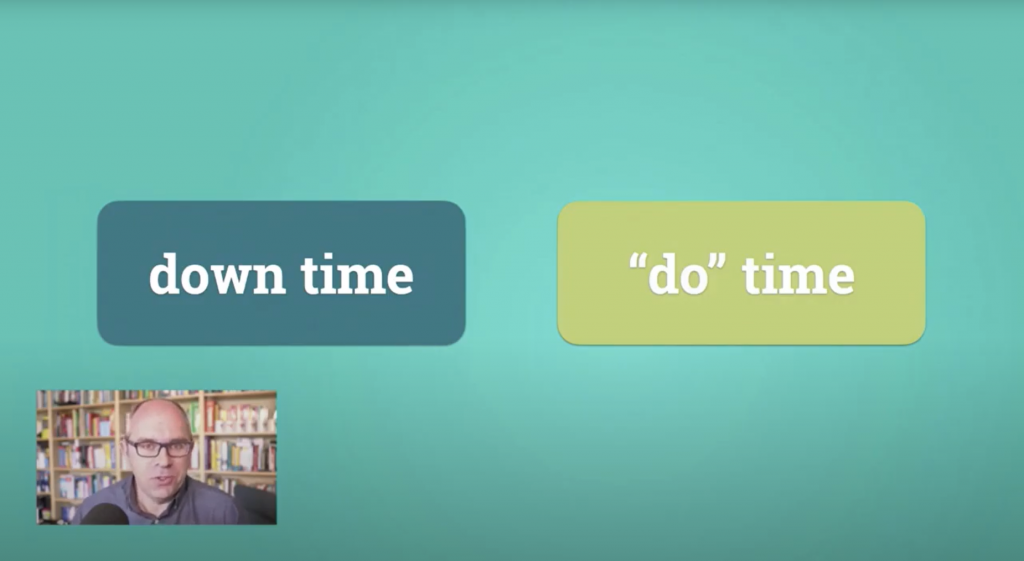
Over the past 14 years we’ve been creating content to allow learners around the world to learn in their coffee breaks or indeed when they’re doing other things like commuting to work or having a walk or something like that. Obviously in the current moment things are a little bit different and we can’t always necessarily get out to do the normal things that we would, but in this presentation I’m hoping to look at ways in which you can turn your down time, the time that you have available and perhaps are using for other things into your do time, and hopefully benefit from that do time and do something valuable with that time that you have available.
So over the next 20 minutes or so we’re going to be looking at 10 tips to help you plan your day around your language learning, and also looking at what I call micro learning, what’s known as micro learning but Coffee Break style, and I’ll explain exactly what I mean by that.
But let’s get started as to our 10 tips to help you plan your day around language-learning, because ultimately when we are trying to learn a language, sometimes we do have time. Sometimes we have time that we can set aside for learning a language. And that perhaps in traditional times may be attending a class or taking an online learning session or something like that. But perhaps it’s a little different now. It’s a little difficult to do that. And what I’d like to do is look at these 10 tips to help you make the most of the time that you have available.
So let’s begin.
Tip no 1 – Start the day well (04:11)
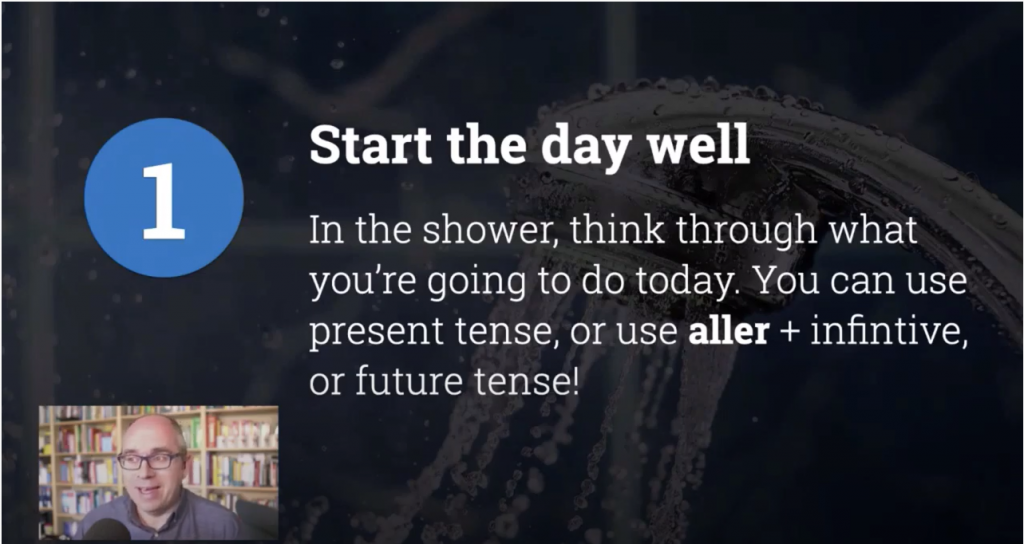
First of all, let’s start at the very beginning of the day, when you’re perhaps having your shower or in the bath or something like that, because what you can start doing even at that point, is planning what you’re going to be doing during the course of the day. So you can think through what you’re doing during the course of the day and talk to yourself, tell yourself what you’re going to do or what you’re doing.
Now, a French example here. You could simply use the present tense and say something like, “Today I go to the park with the children,” or something like that. Or you can give yourself a little more, something more interesting to say. Perhaps at the moment is it’s a little difficult to find interesting things to do, but perhaps you’re going to pick up the weeds in the garden or something like that. So if you know the words and phrases for this, then you can already use them. And if you don’t, then you can look them up and try to … Perhaps not in the shower. Maybe don’t take your phone or your dictionary into the shower. That wouldn’t really be very effective.
But the idea here is that from the very beginning of the day, you’re programming yourself, you’re trying to get yourself into a way of thinking about what it is you’re going to do during that day, but using the language to do that. So whatever language or languages you’re learning, talk through what you’re going to do over the course of the day, perhaps when you’re in the shower.
So that’s your number one tip. Let’s move on and look at number two.
Tip no 2 – Notes, notes, notes (05:31)

Number two is all about notes. I carry a notebook with me wherever I go. I love a real notebook.
I know lots of people like notes apps on their phones for example, but I actually love a real notebook to take notes in. And the kind of notes I take all the time, whatever language I’m particularly learning at that stage, I take notes on words I know, words I don’t know. Perhaps even writing down the words that you are familiar with will help you to reinforce them and consolidate them. And challenge yourself to learn a few words each day and choose the words from your daily experiences.
So whatever you experience during that day, you can choose those words to help you work through your day and take notes along the those lines. Perhaps if you are able to go out and about and you think, “Okay, do I know the word for daffodil, for example, in the language I’m learning?” So if you don’t, write that down and it’s the first thing that you’re going to look up when you get the time to look that up a little later on.
So notes, take them, use whatever method is best for you.
Tip no 3 – Digital immersion (06:38)
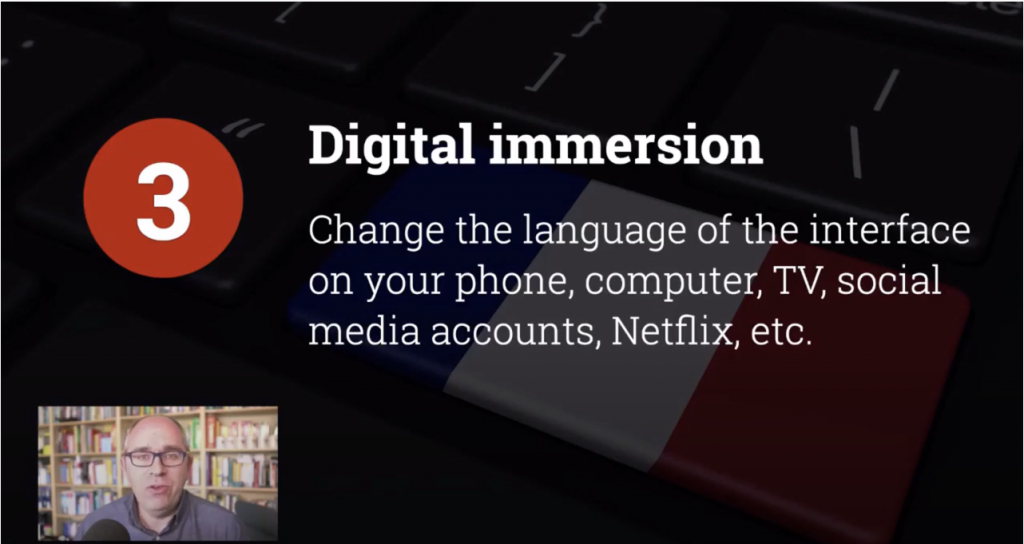
The third suggestion here I have got is all about digital immersion.
So digital immersion, and this is something I’m sure many of you do already, change the language of the interface on your phone, your computer, your TV, your social media accounts, your Netflix account or whatever it happens to be, so that when you experience that, and if you’re doing that regularly, the more you experience it, then the more you can look at the language that you’re learning and the phrases, the words, the interface that you’re using will eventually go in and it will be something that you will recognize without thinking about it.
One of the key things about this is that very often you’re very used to seeing things already. You’ll know where things are. So you’ll know what certain words are in the layout of your Facebook wall or your social media account or whatever it happens to be. So you know where those phrases are. Therefore, you kind of almost know what the words mean in the foreign language. Especially if you’re new to a language, then it is very useful to do this.
So take an opportunity to immerse yourself digitally in the language that you’re learning. One thing I should have perhaps said right at the beginning when I was explaining a little bit Coffee Break, Coffee Break, at Coffee Break we try to create content to help learners learn in whatever way they can. What we often see is that we actually produce the kind of content for learners who don’t believe they are good at learning languages. And many of our community members, or many of the learners in our community are people who perhaps have had poor experiences learning language. Perhaps they tried it at school and it didn’t work for them, or they tried it as an adult and it didn’t quite work for them. And what we try to do is help them achieve that. This is, again, really what we’re focusing on here, little tips that you can use to bring the language into the day as you’re going through your day.
Okay, let’s move on, our fourth tip.
Tip no 4 – Take a virtual tour (08:35)

And this is a little bit trickier now in the sense that what I would also like you to do is take a tour. But perhaps what you could do is take a virtual tour at the moment.
You can use Google Maps Street View to take a virtual tour of a city that you can’t visit at the moment. So if you’re going to maps.google.com and then there’s a little person icon down at the bottom right. You drag that on to a street of the city that you would love to be visiting at the moment. Then you can virtually look around you. And when you’re virtually looking around you, what you can see are shop names, advertisements on walls, billboards and so on, and on the back of buses and things. So you can take this virtual tour without actually being there.
But through doing that, you’ll see lots of examples of the language. And sometimes that is simply about trying to work out what things mean or perhaps practicing your pronunciation. As I’m walking about a foreign city, whatever it happens to be, in times when we were allowed to walk about foreign cities, I always look around myself and try to work out how you would pronounce certain things or ‘why is something spelled in a particular way?’ or on an advert ‘why is there a direct object pronoun there?’, or’ why is it the dative case in German?’ or whatever. (Use) Google Maps Street View or the equivalent on whatever system you use in order to take a virtual tour. Or perhaps you could take a real tour around your house or flat.
Tip no 5 – Take a real tour (10:41)
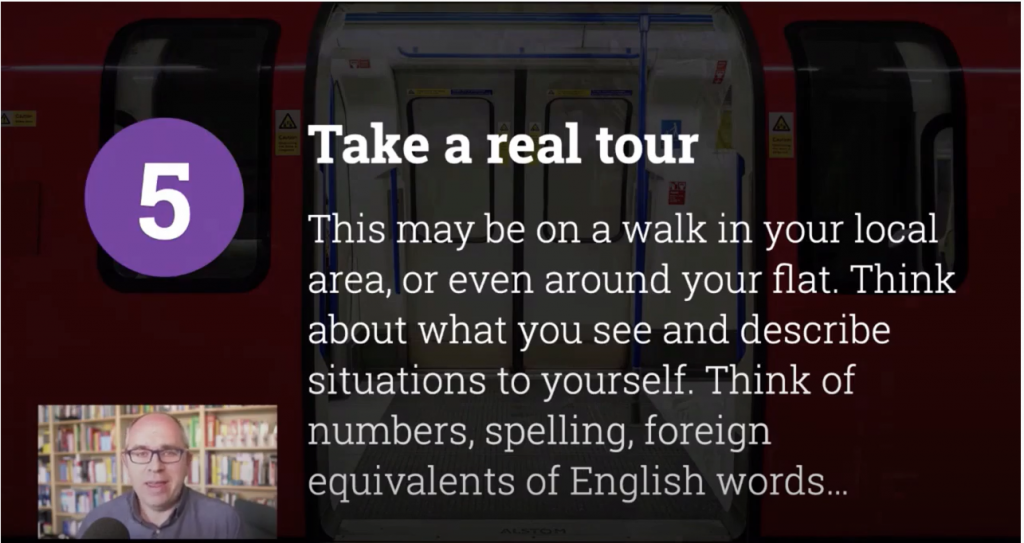
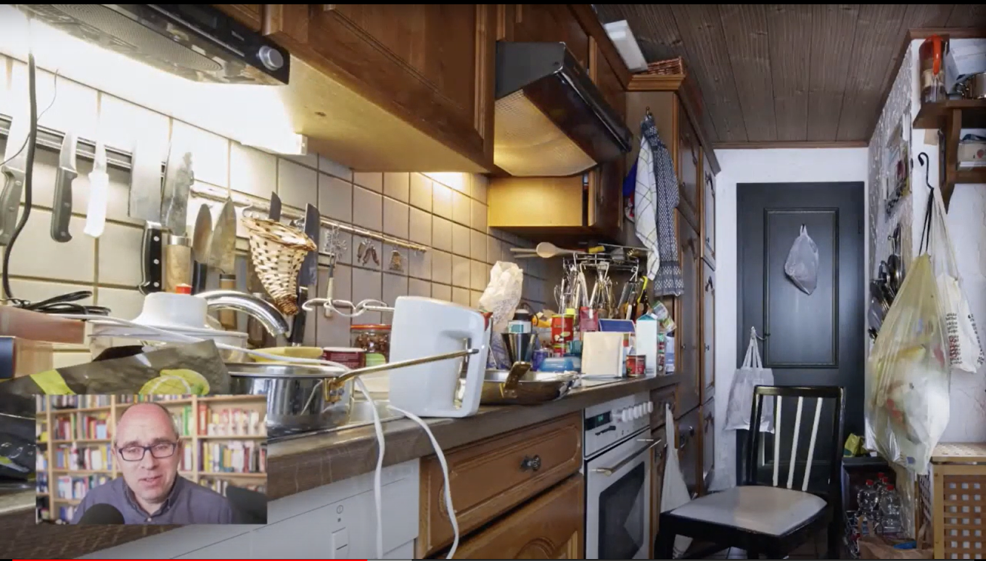
This is just an image of a kitchen. It perhaps needs a little bit of cleaning up and it’s perhaps the reality for a lot of us at the moment. But what I’m suggesting here is take a real tour. And it may be a walk or around your local area if you’re able to do that, or even just around your flat or your home and think about what you see and describe those situations to yourself.
Think of numbers. Think of spelling. Think of foreign equivalents of English words. So when you’re looking around and seeing that messy kitchen or whatever it is, do you know all those words in the language you’re learning? Or is there a description that you can give? Can you say that there is a dirty pan beside the sink? Think of these things and try to come up with simple sentences that you can then try to put into the foreign language. And sometimes it can actually help the whole process of cleaning up, tidying up the kitchen into something that’s useful. Well, obviously it’s useful to tidy up your kitchen, but at the same time it could be useful to learn a little bit of the language while you’re doing that.
So take a real tour if you can, out and about, or if you’re not able to get out and about, even just think about what is around you at the moment. One thing to mention here. We’ve got a video on our YouTube channel called How Learning a Language Can Be a Walk in the Park, and that’s exactly what this video is about. It explains the process of talking to yourself and explaining things. It may just be vocabulary. It may be more complex sentences and so on.
Tip no 6 – Involve those around you (11:47)
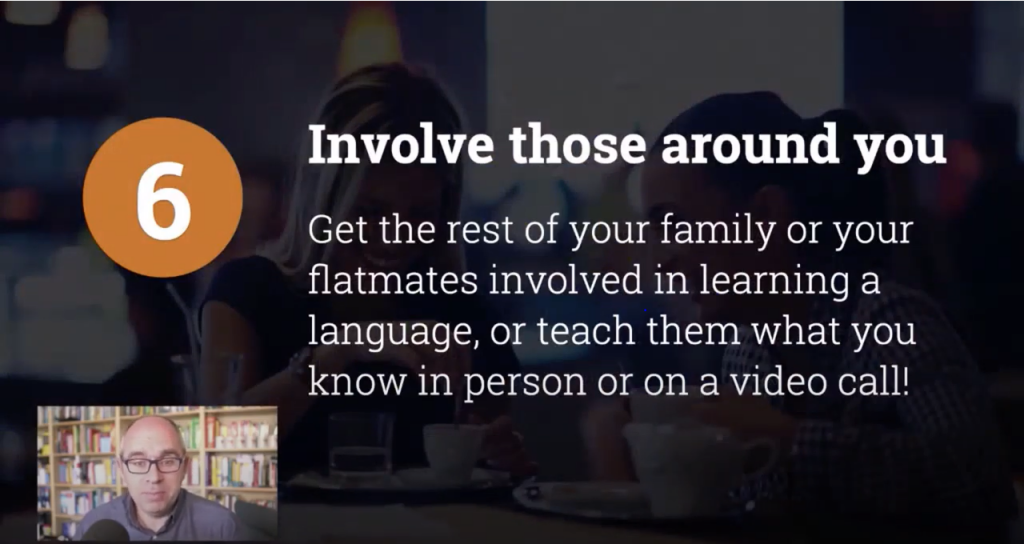
My next suggestion for maximizing your time is get other people involved. If you live with other people, get them involved too in your learning. And that may be your children. It may be while you’re preparing a meal or while they’re helping you prepare the meal, and it’s a great opportunity to focus on vocabulary, focus on instructions and so on. Or it may be getting someone else that you’re living with or whom you can contact on social media or in a video call or something like that. Tell them what you’re learning, and perhaps even teach them what you’ve been learning if they’re willing to learn.
So get the rest of the family or your flatmates involved in learning the language or teach them what you know in person or on a video call. But when you involve other people around you, it gives you that motivation. It gives you also a sense of accountability and that they will want to know what you’ve learned most recently.
Tip no 7 – Use every opportunity (12:44)
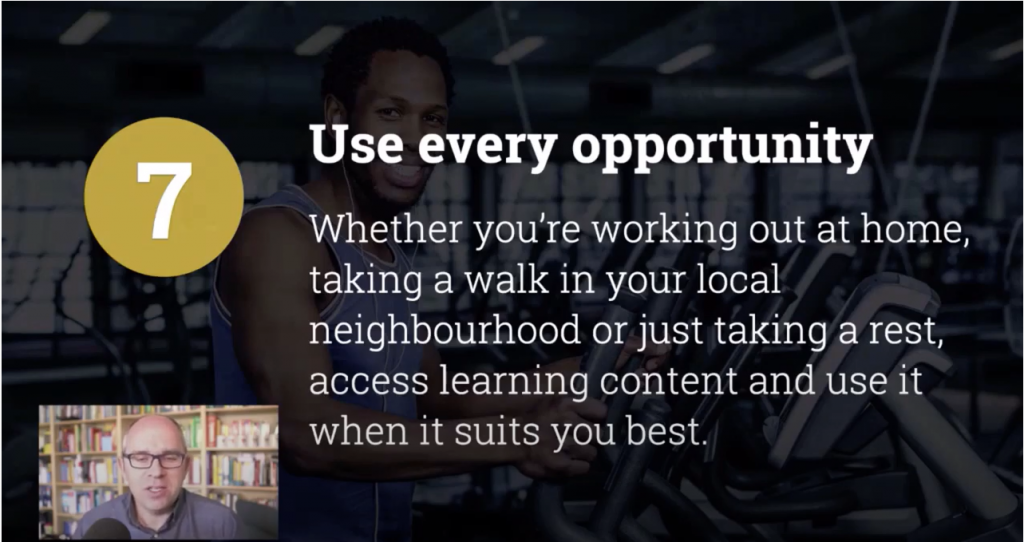
Our next step is all about using the time that you have available to do the important things that you want to do. But you can also combine that with language learning. So for example, use every opportunity, whether you’re doing some fitness, whether you’re taking a walk or just taking a rest. There’s lots and lots of learning content that you can access. And then use that when it suits best. And let me say a little about podcasts.
Obviously we create podcasts, and I think podcasts are a fantastic way of using language learning content because podcasts are the kind of things that you can stop, you can pause, you can listen again, you can slow them down, you can speed them up if you’re listening through something again. Also, the whole idea of a podcast is that podcasts are ongoing content.
So you’ll be notified when there’s a new episode available of the particular podcast that you’re listening to, be that Coffee Break or another podcast. So I definitely think that podcasts are a huge usefully … a very useful tool in your language learning and they will fit around what is you’re doing, whether that’s working out, whether it’s taking a walk, or just relaxing.
Tip no 8 – Track your successes (13:46)
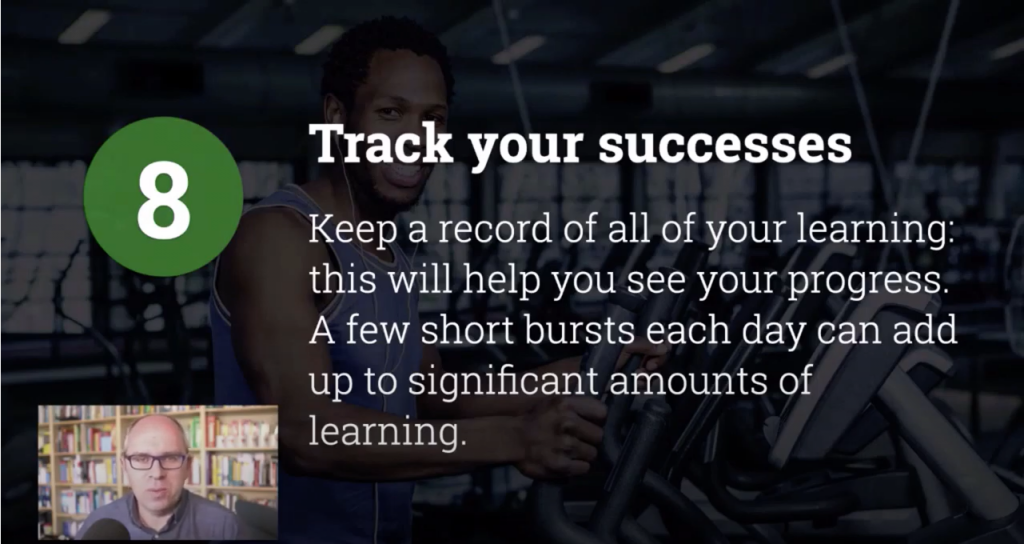
Okay, moving on and this one is very important as well. It’s more than just taking notes. It’s tracking your success.
I would like you to keep a record of all your learning, and that is everything that you do. So every time you do a little bit of learning, whether it’s a walk and you noted a few words, or you’re describing your messy kitchen or something like that, all of this language learning counts. It will help you to see your progress.
Remember, that a few short bursts of learning every day can add up to significant amounts of learning over time. Sometimes we do feel, “Oh, I’m not making the progress that I’d like to with learning.” But actually when you see it written down and you see, “Well, I’ve spent five minutes a night, oh I did a 20 minute podcast while I was working out,” it does begin to add up and you begin to see, “Well actually, I have done quite well today,” and that helps your motivation too.
I also like to use an app to track my successes. There are many apps available. The one I use is called Streaks on iOS. And Streaks allows you to keep a track of what you’ve been able to do. You can set up, for example, learned five new verbs, did a reading passage, listened to a podcast. There are six things that you can set up on each screen. And you can simply tap them as you complete them. Also lets you set up, for example, if you’re learning six new verbs, you can set up six little segments, so each time you learn a new verb or you learn a new piece of vocabulary or whatever happens to be, you can track that very easily.
Tip no 9 – Plan tomorrow today (15:47)
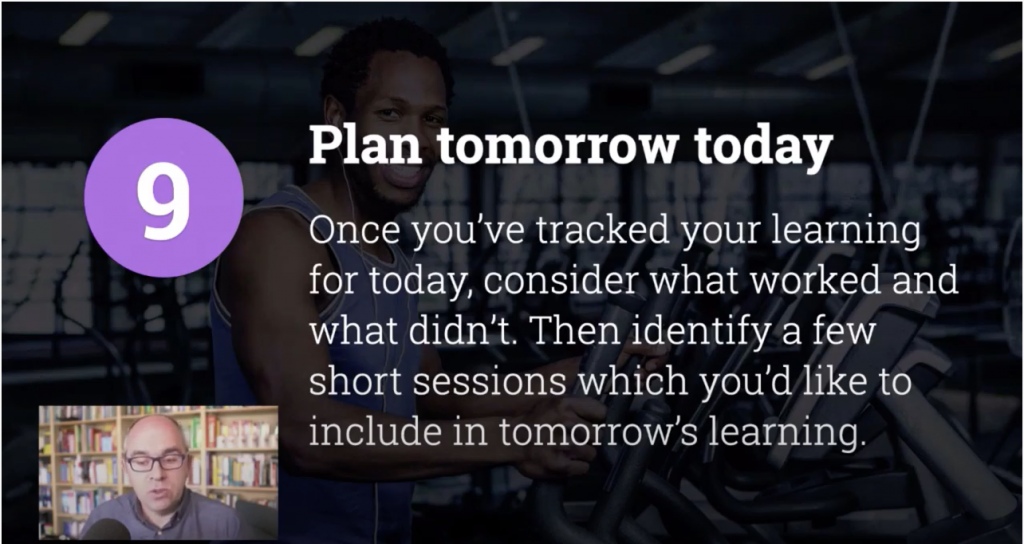
Our next suggestion here, number nine is about really planning your day around the whole day. And when it gets to the end of the day, basically planning tomorrow. So at the end of the day, plan tomorrow. So plan tomorrow today.
Once you’ve tracked your learning for today, consider what worked and what didn’t. Then identify a few short sessions which you’d like to include in tomorrow’s learning. Basically the idea would be that if you’re getting to the end of the day and you’re thinking, “Well, that worked really well when I went to walk today, or I spent some time in the garden listening to a podcast. So I’ll try to do that again tomorrow.” And perhaps try to schedule it.
And if you’ve got that, the possibility of doing that, by planning tomorrow, it means that you’re already set up for the day before you even reach that day. So as soon as you hit the shower in the morning, you know what you’re going to be doing for the rest of the day.
Tip no 10 – At the end of the day… (16:37)
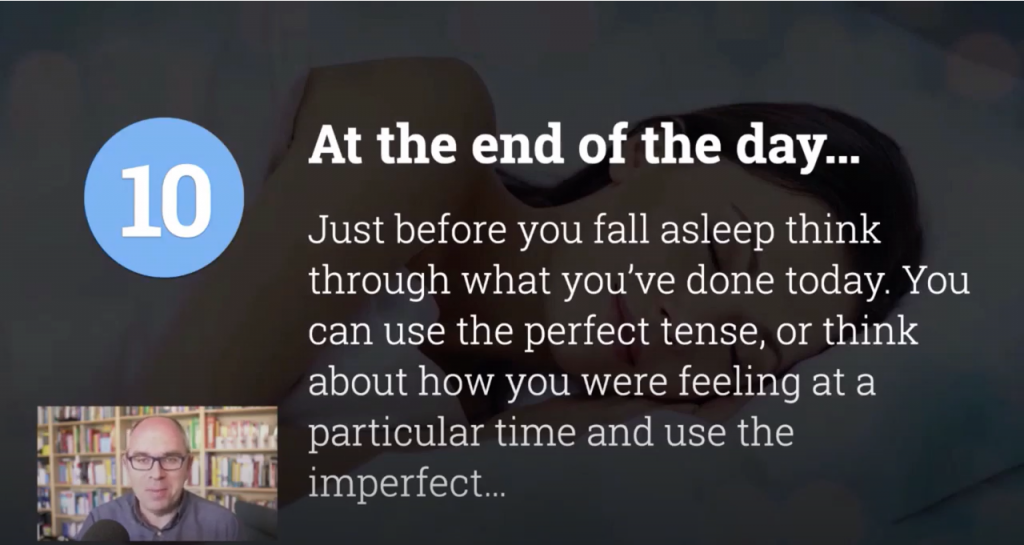
And finally, when your head hits the pillow at night, then make sure you’re also thinking about the language.
I know that may be a little tough, but just before you fall asleep, think through what you’ve done today, and again, in the foreign language. So tell yourself what you’ve achieved, tell yourself what you’ve done in simple sentences. Again, you could use, well, depending on which language you’re learning, you could use the perfect tense or the present tense or the past tense, or you could describe your feelings using imperfect or obviously it depends on the language that you’re learning. But at the end of the day, try to see perhaps three or four things that you have done in the course of that day, and that ensures that your day from the beginning to the end has been about learning languages.
Quick language challenges
We’ve looked at 10 tips to help you plan around you, plan your day around language learning Let me share now very quickly just a few little pieces of information or a few suggestions about micro learning Coffee Break style. What I mean by that is literally you can fit learning into just a few minutes. So if you’ve only got two minutes, you can do something useful within your language. And we’re going to do that right now.
2 Minute Learning: Unscramble the Spanish word (17:22)
Coffee Break – Espresso
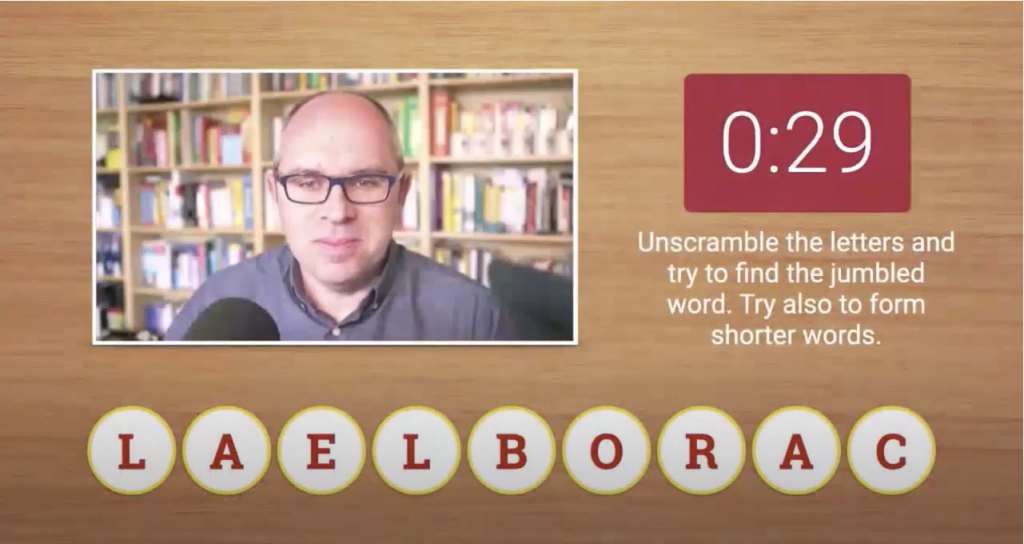
I’ve got here a challenge. It’s a Spanish challenge. You’re going to get nine letters. You’ve got to unscramble those nine letters into one word. But if you don’t, can’t find that one word, then perhaps you can find other words that are made up from the letters that you see. So here we go, 30 seconds to unscramble the Spanish words.
So if you are a Spanish learner, you should have worked out, or perhaps should have worked out that that was CABALLERO, a gentleman or originally a knight.
But there were other words there, for example, LO, BAR, CALA is a cove, CEBOLLA is an onion, LLORABA, he or she was crying from the verb LLORAR and again, CABALLERO. So literally 30 seconds there we took to work out what that word meant.
So literally within those two minutes that we’ve suggested you can do things like that.
And if you can’t find word games, you can make them up yourself. There’s a site called wordmine.info. And you can ask this site to find, I don’t know, like 20 words in German that have 10 letters in them and things like that. So first of all, play a word game if you can, or just look around you and identify unknown vocabulary. So just picking out a couple of things from what you see around you.
5 Minute Learning: Social Media (19:57)
Coffee Break – Double Espresso
If you’ve got more than two minutes, five minutes time for perhaps a slightly longer coffee. That was our espresso, very much an espresso shot of learning. Perhaps there’s a double espresso or something like that. And if you’ve got five minutes, then again, there are lots of things you can do.
For example, look at social media. There are lots of language learning accounts. We’ve got our Instagram account there where we post many language lessons all the time.
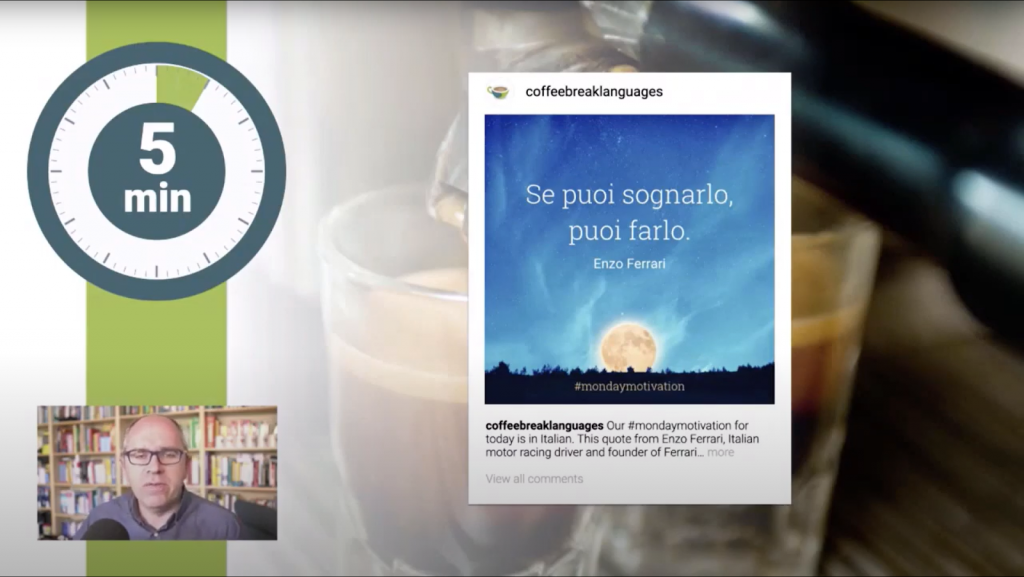
So in Italian, SE PUOI SOGNARLO PUOI FARLO, if you can dream it, you can do it. And you can think about that, “Well, why is there a direct object to a noun stuck on the end of that infinitive,” and think about what you’re seeing there. So whether it’s browsing Instagram, revisiting your notes, playing lucky dip.
What I like to do with lucky dip is basically open a dictionary and see which words I know from where my finger lands. And if there are not any words there that I know, then I’ll write some down in my notebook. Or check your flashcards. If you use a flashcards app, then you can check your flashcards quickly within those five minutes.
10 Minute Learning: YouTube (21:00)
Coffee Break – Latte
If you get 10 minutes time for perhaps a relaxed latte or a latte macchiato or something like that, then perhaps it would be a good time to watch a YouTube video. We’ve got a huge selection of YouTube videos on our account. Of course, there are hundreds of thousands of fantastic YouTube videos for learners.
So watch a YouTube video or check out today’s headlines. You can find, in fact there are sites online where you can find all the … almost all the newspapers in the world and the front page of them. So just check out the headlines and see what you can understand from that. Or perhaps listen to a song and identify finding new words that you didn’t know in that song. Again, you’ll be able to find lyrics easily online to try that. So 10 minute tips there you can use for your language learning.
More learning ideas (21:46)
Coffee Break – Coffee and Cake
And if you’ve got a little longer perhaps time for a coffee and a bit of cake or kuchen perhaps, then perhaps you could listen to a podcast or plan your next live session or a night live lesson. Or perhaps research a recipe for tonight’s dinner and look up the recipe in the foreign language, see all the vocabulary that you need there, check that you’ve got the ingredients, and then perhaps make it with your family and talk about the words later on in the day.
So just a few quick tips there to show you that even if you’ve just got two minutes or five minutes or 10 minutes, then you’re still able to do some language learning and fit them into the course of the day.
Okay. That is what I have to share with you today. I hope that you have found this useful and I hope that it gives you a chance to optimize your day so that you can maximize your language learning. Thank you very much for listening.
Q & A (23:09)
How do you design content for brand new beginners to kind of get into a language for the first time versus more experienced learners?
Yeah, so when we are planning our content for absolute beginners, all of our courses start at an absolute beginner level, so A1, in fact, pre-A1, really, really basic stuff.
One of the things that we focus on hugely at the beginning is pronunciation because we feel that if you can start to lay firm foundations with good pronunciation, then that’s very useful. It will help you build on that later.
In terms of the content, all of our podcasts at the beginning feature a lot of English. We are teaching the foreign language through English. And in all of the podcasts, as you remember from Coffee Break, we have a learner. So the teacher is working with a learner. For example, we are recording Coffee Break Swedish at the moment and I am the learner in Coffee Break Swedish. I’m learning Swedish along with Hannah, our teacher.
So a lot happens in English, but because there’s a learner there, the learner is asking questions and also getting things wrong. So the teacher is helping the learner and correcting those mistakes that the learner may make and so on. So the content at the early stages is very much supported with a teacher, with the learner and also with a lot of English to begin with.
Some people like lots of input in the foreign language. We believe and our listeners feed this back to us that in actual fact if you are building up the motivation to learn a language from the beginning, perhaps listening to 10 minutes of the language with no English scaffolding at all is going to be quite a challenge. And whether you can keep that going, yes, you would pick up the rhythms of the language, you’d pick up the pronunciation, but will you understand everything?
That’s why we include a lot of English from the early stages. And then that English comes out as we gradually move through the seasons.
Somebody who’s asking how you work on your pronunciation in a really effective manner? You’re a podcast, so you can’t really get feedback from the student or give them feedback. If you’re learning a language, how do you go about improving your own pronunciation?
By listening. By listening as much as they possibly can to different accents. I am addicted to Netflix shows. I watch a lot of Netflix and try to listen as much as possible. But I think also trying to see things, again, all this idea of talking to yourself in the shower where no one can hear you. That’s probably quite a good idea. If you’re out and about, even talking. I do talk to myself quite a lot. And although you’re not getting the immediate feedback from a teacher that’s … You can’t necessarily go for a walk with a teacher, but you can compare what you’re saying to what is being said on a podcast for example, and trying to work on that.
I think also the sounds, depending on what language you’re working on, the sounds of the language will be quite new to you. So you’ll be learning things like in Swedish where we’re learning the sj-sound, which is quite a tricky sound to produce at the beginning, but really trying to break that sound down. And if you’ve got the opportunity like I had within the podcast to ask Hannah, our teacher, so what are you doing with your mouth at that point, and we can actually see what’s happening with the mouth and that helps you to pick up these sounds.
So use every opportunity that you have to interact with a teacher. Perhaps that could be on something like Italki or other platforms where you’re working directly with a native speaker to analyze how they are saying things. And don’t be afraid to ask a native speaker that you’re working with in a Skype conversation, for example, to really pronounce very slowly and into the camera in a clear way so that you can actually see what’s happening with their mouth to make that sound.
